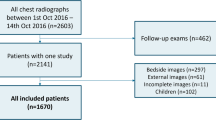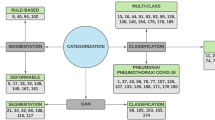Abstract
Purpose
The study aims to develop an unsupervised framework using COVGANs to learn better visual representations of COVID-19 from unlabeled X-ray and CT scans.
Methods
We trained multiple-layer GANs to develop the COV-GAN framework on unlabeled X-ray and CT scans. We evaluated the quality of the learned representations using t-SNE visualization, K-means, and GMM clustering. The proposed unsupervised method’s performance was compared with leading unsupervised methods for COVID-19 classification on X-ray and CT scans.
Results
Our method achieved an accuracy of 75.1% on X-ray scans and 75.7% on CT scans, which is at least 13.9% and 12.3% higher than the leading unsupervised methods for COVID-19 classification on X-ray and CT scans, respectively. The t-SNE visualization, K-means, and GMM clustering showed that our method learned better visual representations of COVID-19 from unlabeled data.
Conclusions
Our unsupervised framework using COV-GANs can learn better visual representations of COVID-19 from unlabeled X-ray and CT scans. The learned representations can improve the performance of COVID-19 classification. The outcomes show the potential of unsupervised learning methods to overcome the dearth of labelled data in the medical profession, particularly in times of public health crises like the COVID-19 epidemic.








Similar content being viewed by others
Availability of data and material
The data that support the findings of this study are available from the first author upon reasonable request.
Code availability
The code is available from the first author upon reasonable request.
References
World Health Organization. WHO Director-General’s opening remarks at the media briefing on COVID-19. January 30 2022.
WHO Coronavirus (COVID-19) Dashboard. http://covid19.who.int/?gclid=CjwKCAjw8KmLBhB8EiwAQbqNoAQF669E29xtQxZeOrBjBOEg0WZ3X_2OgH4h32GnFPEmy8bqhY3nPBoCkfMQAvD_BwE. Accessed 27 Apr 2024.
WHO Coronavirus (COVID-19) Dashboard. https://covid19.who.int/. Accessed 27 Apr 2024.
Wang S, Kang B, Ma J, Zeng X, Xiao M, Guo J, Cai M, Yang J, Li Y, Meng X, et al. A deep learning algorithm using ct images to screen for corona virus disease (covid-19). Eur Radiol. 2021;1–9.
Shi F, Wang J, Shi J, Wu Z, Wang Q, Tang Z, He K, Shi Y, Shen D. Review of artificial intelligence techniques in imaging data acquisition, segmentation and diagnosis for covid-19. IEEE Rev Biomed Eng. 2020.
Pham TD. A comprehensive study on classification of covid-19 on computed tomography with pretrained convolutional neural networks. Sci Rep. 2020;10(1):1–8.
Wang L, Lin ZQ, Wong A. Covid-net: a tailored deep convolutional neural network design for detection of covid-19 cases from chest x-ray images. Sci Rep. 2020;10(1):1–12.
Duran-Lopez L, Dominguez-Morales JP, Corral-Jaime J, Vicente-Diaz S, Linares-Barranco A. Covid-xnet: a custom deep learning system to diagnose and locate covid-19 in chest x-ray images. Appl Sci. 2020;10(16):5683.
Apostolopoulos ID, Aznaouridis SI, Tzani MA. Extracting possibly representative covid-19 biomarkers from x-ray images with deep learning approach and image data related to pulmonary diseases. J Med Biol Eng. 2020;40:462–9. https://doi.org/10.1007/s40846-020-00529-4.
Farooq M, Hafeez A. Covid-resnet: a deep learning framework for screening of covid19 from radiographs. arXiv preprint arXiv:2003.14395. 2020.
Afshar P, Heidarian S, Naderkhani F, Oikonomou A, Plataniotis KN, Mohammadi A. Covid-caps: a capsule network-based framework for identification of covid-19 cases from x-ray images. Pattern Recogn Lett. 2020;138:638–43.
Wu Y-H, Gao S-H, Mei J, Xu J, Fan D-P, Zhang R-G, Cheng MM. Jcs: an explainable covid-19 diagnosis system by joint classification and segmentation. IEEE Trans Image Process. 2021.
Roth HR, Lu L, Liu J, Yao J, Seff A, Cherry K, Kim L, Summers RM. Improving computer-aided detection using convolutional neural networks and random view aggregation. IEEE Trans Med Imaging. 2015;35(5):1170–81.
Tajbakhsh N, Shin JY, Gurudu SR, Hurst RT, Kendall CB, Gotway MB, Liang J. Convolutional neural networks for medical image analysis: Full training or fine tuning? IEEE Trans Med Imaging. 2016;35(5):1299–312.
Goodfellow IJ, Pouget-Abadie J, Mirza M, Xu B, Warde-Farley D, Ozair S, Courville A, Bengio Y. Generative adversarial networks. arXiv preprint arXiv:1406.2661. 2014.
Lin D, Fu K, Wang Y, Xu G, Sun X. Marta gans: unsupervised representation learning for remote sensing image classification. IEEE Geosci Remote Sens Lett. 2017;14(11):2092–6.
Yadav P, Menon N, Ravi V, Vishvanathan S. Lung-gans: unsupervised representation learning for lung disease classification using chest ct and x-ray images. IEEE Trans Eng Manag. 2021. https://doi.org/10.1109/TEM.2021.3103334.
Khan AI, Shah JL, Bhat MM. Coronet: a deep neural network for detection and diagnosis of covid-19 from chest x-ray images. Comput Methods Programs Biomed. 2020;196:105581.
Oh Y, Park S, Ye JC. Deep learning covid-19 features on cxr using limited training data sets. IEEE Trans Med Imaging. 2020;39(8):2688–700.
Wang X, Deng X, Fu Q, Zhou Q, Feng J, Ma H, Liu W, Zheng C. A weakly-supervised framework for covid-19 classification and lesion localization from chest ct. IEEE Trans Med Imaging. 2020;39(8):2615–25.
Xu Z, Cao Y, Jin C, Shao G, Liu X, Zhou J, Shi H, Feng J. Gasnet: weakly-supervised framework for covid-19 lesion segmentation. arXiv preprint arXiv:2010.09456. 2020.
Zhou J, Jing B, Wang Z. Soda: detecting covid-19 in chest x-rays with semisupervised open set domain adaptation. arXiv preprint arXiv:2005.11003. 2020.
Calderon-Ramirez S, Moemeni A, Elizondo D, Colreavy-Donnelly S, Chavarria-Estrada LF, Molina-Cabello MA, et al. Correcting data imbalance for semi-supervised covid-19 detection using x-ray chest images. arXiv preprint arXiv:2008.08496. 2020.
Berthelot D, Carlini N, Goodfellow I, Papernot N, Oliver A, Raffel C. Mixmatch: A holistic approach to semi-supervised learning. arXiv preprint arXiv:1905.02249. 2019.
Alshazly H, Linse C, Abdalla M, Barth E, Martinetz T. Covid-nets: deep CNN architectures for detecting COVID-19 using chest CT scans. medRxiv. 2021.
Narin A, Kaya C, Pamuk Z. Automatic detection of coronavirus disease (covid-19) using x-ray images and deep convolutional neural networks. Pattern Anal Appl. 2021. https://doi.org/10.1007/s10044-021-00984-y.
Born J, Wiedemann N, Cossio M, Buhre C, Brändle G, Leidermann K, Goulet J, Aujayeb A, Moor M, Rieck B, et al. Accelerating detection of lung pathologies with explainable ultrasound image analysis. Appl Sci. 2021;11(2):672. https://doi.org/10.3390/app11020672.
Wang S, Kang B, Ma J, Zeng X, Xiao M, Guo J, Cai M, Yang J, Li Y, Meng X, Xu B. A deep learning algorithm using CT images to screen for corona virus disease (COVID-19). Eur Rad. 2021;6096–104.
Kim CK, Choi JW, Jiao Z, Wang D, Wu J, Yi TY, Halsey KC, Eweje F, Tran TM, Liu C, Wang R. An automated COVID-19 triage pipeline using artificial intelligence based on chest radiographs and clinical data. NPJ Digit Med. 2022;5(1):5.
Gour M, Jain S. Automated COVID-19 detection from X-ray and CT images with stacked ensemble convolutional neural network. Biocybern Biomed Eng. 2022;42(1):27–41. https://doi.org/10.1016/j.bbe.2021.12.001.
Bermejo-Peláez D, San José Estépar R, Fernández-Velilla M, Palacios Miras C, Gallardo Madueño G, Benegas M, Gotera Rivera C, Cuerpo S, Luengo-Oroz M, Sellarés J, Sánchez M. Deep learning-based lesion subtyping and prediction of clinical outcomes in COVID-19 pneumonia using chest CT. Sci Rep. 2022;12(1):9387. https://doi.org/10.1038/s41598-022-13298-8.
Hardy-Werbin M, Maiques JM, Busto M, Cirera I, Aguirre A, Garcia-Gisbert N, Zuccarino F, Carbullanca S, Del Carpio LA, Ramal D, Gayete Á. MultiCOVID: a multi modal deep learning approach for COVID-19 diagnosis. Sci Rep. 2023;13(1):18761. https://doi.org/10.1038/s41598-023-46126-8.
Di Napoli A, Tagliente E, Pasquini L, Cipriano E, Pietrantonio F, Ortis P, Curti S, Boellis A, Stefanini T, Bernardini A, Angeletti C. 3D CT-inclusive deep-learning model to predict mortality, ICU admittance, and intubation in COVID-19 patients. J Digit Imaging. 2023;36(2):603–16. https://doi.org/10.1007/s10278-022-00734-4.
Oi Y, Ogawa F, Yamashiro T, Matsushita S, Oguri A, Utada S, Misawa N, Honzawa H, Abe T, Takeuchi I. Prediction of prognosis in patients with severe COVID-19 pneumonia using CT score by emergency physicians: a single-center retrospective study. Sci Rep. 2023;13(1):4045.
Xie P, Zhao X, He X. Improve the performance of CT-based pneumonia classification via source data reweighting. Sci Rep. 2023;13(1):9401.
Miyazaki A, Ikejima K, Nishio M, Yabuta M, Matsuo H, Onoue K, Matsunaga T, Nishioka E, Kono A, Yamada D, Oba K. Computer-aided diagnosis of chest X-ray for COVID-19 diagnosis in external validation study by radiologists with and without deep learning system. Sci Rep. 2023;13(1):17533.
Abad M, Casas-Roma J, Prados F. Generalizable disease detection using model ensemble on chest X-ray images. Sci Rep. 2024;14(1):5890.
Sadeghi A, Sadeghi M, Sharifpour A, Fakhar M, Zakariaei Z, Sadeghi M, Rokni M, Zakariaei A, Banimostafavi ES, Hajati F. Potential diagnostic application of a novel deep learning-based approach for COVID-19. Sci Rep. 2024;14(1):280.
King, B., Barve, S., Ford, A., Jha, R.: Unsupervised clustering of covid-19 chest x-ray images with a self-organizing feature map. In: 2020 IEEE 63rd International Midwest Symposium on Circuits and Systems (MWSCAS). IEEE. 2020. p. 395–98.
Mansour RF, Escorcia-Gutierrez J, Gamarra M, Gupta D, Castillo O, Kumar S. Unsupervised deep learning based variational autoencoder model for covid-19 diagnosis and classification. Pattern Recogn Lett. 2021;151:267–74. https://doi.org/10.1016/j.patrec.2021.08.018.
Rashid N, Hossain MAF, Ali M, Islam Sukanya M, Mahmud T, Fattah SA. Autocovnet: unsupervised feature learning using autoencoder and feature merging for detection of covid-19 from chest x-ray images. Biocybern Biomed Eng. 2021;41(4):1685–701. https://doi.org/10.1016/j.bbe.2021.09.004.
Alizadehsani R, Sharifrazi D, Izadi NH, Joloudari JH, Shoeibi A, Gorriz JM, Hussain S, Arco JE, Sani ZA, Khozeimeh F, et al. Uncertainty-aware semi-supervised method using large unlabelled and limited labeled covid-19 data. arXiv preprint arXiv:2102.06388. 2021.
Waheed A, Goyal M, Gupta D, Khanna A, Al-Turjman F, Pinheiro PR. Covidgan: data augmentation using auxiliary classifier gan for improved covid-19 detection. Ieee Access. 2020;8:91916–23.
Loey M, Smarandache FM, Khalifa NE. Within the lack of chest covid-19 x-ray dataset: a novel detection model based on gan and deep transfer learning. Symmetry. 2020;12(4).
Odena A, Dumoulin V, Olah C. Deconvolution and checkerboard artifacts. Distill. 2016;1(10):3.
El-Shafai W. Extensive COVID-19 X-Ray and CT chest images dataset. Mendeley. 2020. https://doi.org/10.17632/8H65YWD2JR.3. https://data.mendeley.com/datasets/8h65ywd2jr/3.
Guo X, Liu X, Zhu E, Yin J. Deep clustering with convolutional autoencoders. In: Liu D, Xie S, Li Y, Zhao D, El-Alfy ES, editors. Neural information processing. ICONIP 2017. Lecture Notes in Computer Science, vol. 10635. Cham: Springer; 2017. https://doi.org/10.1007/978-3-319-70096-0_39.
Guo X, Gao L, Liu X, Yin J. Improved deep embedded clustering with local structure preservation. In: IJCAI. 2017. p. 1753–59.
Maaten L, Hinton G. Visualizing data using t-sne. J Mach Learn Res. 2008;9(11).
Funding
None.
Author information
Authors and Affiliations
Contributions
Neeraj Menon: Conceptualization, Methodology, Software, Writing – original draft, Writing – review & editing, Validation. Pooja Yadav: Conceptualization, Methodology, Software, Writing – original draft, Writing – review & editing, Validation. Vinayakumar Ravi: Conceptualization, Methodology, Software, Writing – original draft, Writing – review & editing, Validation, Supervision. Vasundhara Acharya: Conceptualization, Methodology, Software, Writing – original draft, Writing – review & editing, Validation. Sowmya V: Conceptualization, Methodology, Software, Writing – original draft, Writing – review & editing, Validation.
Corresponding author
Ethics declarations
Informed consent
None.
Conflict of interest
The authors declare no conflict of interest.
Additional information
Publisher's Note
Springer Nature remains neutral with regard to jurisdictional claims in published maps and institutional affiliations.
Rights and permissions
Springer Nature or its licensor (e.g. a society or other partner) holds exclusive rights to this article under a publishing agreement with the author(s) or other rightsholder(s); author self-archiving of the accepted manuscript version of this article is solely governed by the terms of such publishing agreement and applicable law.
About this article
Cite this article
Menon, N., Yadav, P., Ravi, V. et al. Unsupervised generative learning-based decision-making system for COVID-19 detection. Health Technol. (2024). https://doi.org/10.1007/s12553-024-00879-y
Received:
Accepted:
Published:
DOI: https://doi.org/10.1007/s12553-024-00879-y




